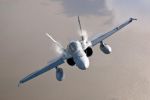Ramstein, 20 March 12 – A Lithuanian Air Force C‑27 Spartan loses communication above international waters in the Baltic Sea. What needs to happen to bring the transport aircraft back safely?
 |
| Finnish F‑18 Hornet, copyright to Finnish Air Force, Frank Crébas Source: NATO Click to enlarge |
This is the scenario during the Baltic Region Training Event (BRTE) XI conducted by HQ AC Ramstein in Lithuania on 27 and 28 March which involves German F‑4F Phantom fighters, presently stationed at Šiauliai Air Base to ensure NATO’s Air Policing Mission. The Phantoms will train hand-over procedures with Swedish JAS-39 Gripen fighters and Finnish F‑18 Hornet fighters, respectively.
“This is the first time Finland takes part in this series of training events,” says Colonel Lone Traeholt, Royal Danish Air Force, branch head in the operations division of HQ AC Ramstein, “for Sweden it is the second participation. BRTE XI is an excellent chance to train realistic scenarios with our Partner air forces.”
On 27 March, Swedish JAS-39 Gripen fighter aircraft will intervene the C‑27 Spartan in Swedish airspace and escort it back towards Lithuania, where the NATO Quick Reaction Alert (Intercept) or QRA(I) fighter aircraft – German Air Force F‑4F Phantom aircraft will take over and escort it back to Šiauliai.
“We’ve made friends here in the Baltic States and the Baltic Air Policing mission has meanwhile become a routine event for the German Air Force,” says Lieutenant Colonel Holger Radmann, commander of the German Phantom contingent at Šiauliai, “it is important that we use opportunities like the BRTE series to further practise and execute procedures in close coordination with partner nations to ensure safety of the NATO airspace.”
On 28 March the same scenario will be executed with Finnish F‑18 Hornets, and a media event will take place at Šiauliai Air Base.
“You can imagine that all these procedures require a lot of preparation and coordination,” says Colonel Traeholt, “and the purpose of this BRTEs is to practise between NATO and Partner air and ground crews to enable them to execute their job properly across borders. We are not just looking at pilots though but also at the operators in the air command and control centres in Lithuania, Germany, Finland and Sweden.”
These facilities are the joint Baltic Control and Reporting Centre at Karmelava, the NATO Combined Air Operations Centre at Uedem, Germany, as well as a Swedish and a Finnish Air Operations Centre.
“We appreciate the opportunity to take part in this NATO event for the first time as it helps us to learn NATO procedures that apply to airspace safety,” says Lieutenant Colonel Pasi Jokinen, Finnish Air Force, “the exchange of experience helps us to deepen professional cooperation between air forces.”
“Sweden took part already during BRTE VIII last March,” says Lieutenant Colonel Robert Persson, Swedish Air Force, “and this time we can build on what we established and train another of our QRA(I) assets in working with the Alliance.”
“We are always pleased to host these Allied training events here at Šiauliai,” says Colonel Jucius Antanas, Chief of Staff of the Lithuanian Air Force, “and we are looking forward to this outstanding opportunity to train our national, Allied and Partner air forces.”
Source:
Allied Command Operations
NATO

 von
von